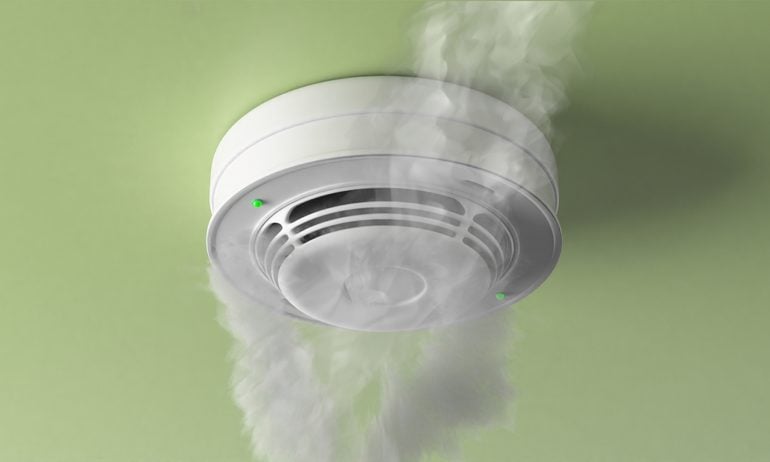House Fires: Causes and How to Prevent Them
A lot of things can cause house fires, but a lot of things can prevent them, too.

Some or all of the mortgage lenders featured on our site are advertising partners of NerdWallet, but this does not influence our evaluations, lender star ratings or the order in which lenders are listed on the page. Our opinions are our own. Here is a list of our partners.
Some of the most common causes of house fires include cooking accidents, electrical malfunctions, home heating incidents, indoor smoking, candles and holiday-related issues. According to the U.S. Fire Administration, residential fires caused $10.8 billion of property damage in 2022 alone .
Some preventive measures and planning can help keep you and your home safe.
Cooking fires
Kitchens are the leading location of home fires .
Causes of cooking fires
Foods are unattended over a lit burner.
Overheated or spilled oils ignite.
Flammable materials such as paper products, recipe books, food packaging or rags are left too close to the stove.
Loose-fitting clothing hangs into the flame or gets caught on a burner.
Cooking temperature (or flame) is too high .
How to reduce the chances of a cooking fire
Never leave frying, broiling or grilling foods unattended. If you leave the kitchen, even just for a few minutes, turn off the stove.
Keep a fire extinguisher in the kitchen, within easy reach, and check periodically to make sure it has a full charge.
Keep young children and pets at least 3 feet from the stove or oven.
When cooking, wear close-fitting clothing with tightly rolled-up sleeves.
Keep a pan lid nearby when you’re cooking, so that if a grease fire erupts in a pot or pan, you can cover it with the lid to contain and smother the fire.
Pot handles should be turned toward the back of the stove, so they can’t be accidentally knocked into and pulled down.
Keep all flammable and combustible materials such as paper, rags and cleaning chemicals far away from heat sources.
No matter how chilly you’re feeling, never use your stovetop or oven to heat your home.
When cooking foods for long periods, use a timer to remind you that you’ve got something cooking.
Check kitchen appliances to make sure they’re working properly and free of flammable grease buildup.
Don’t cook if you’re too tired or stressed to pay attention to your cooking .
Many home security systems come with or offer smoke detectors or devices that listen for the sound of a smoke alarm. Check out our picks for the year's best home security systems.
Electrical and appliance fires
Electrical fires not only cause injury and death, but they’re also the leading cause of property damage from house fires .
Causes of electrical and appliance fires
Faulty wiring.
Overloaded circuits.
Frayed or improperly used electrical cords.
Accumulated dryer lint.
Overheated, improperly maintained, poorly ventilated or defective appliances and batteries.
How to reduce your chances of an electrical or appliance fire
Clean the lint filter in your dryer after every load. Dryer fires alone caused about $81 million in property losses in 2020 .
Never run electrical cords under furniture, carpeting or rugs.
Replace all frayed or worn appliance cords.
If a light switch feels hot when you touch it, or if the lights are flickering, turn off the fixture or switch immediately and call a professional electrician.
If a wall feels hot when you touch it (and there isn’t a heating or hot water pipe behind it), or if you smell something burning in a wall, call the fire department immediately.
Never force three-prong appliance cords into two-prong outlets or extension cords.
Only use portable generators in well-ventilated outdoor areas.
Only plug one high-wattage appliance into an electrical outlet to avoid overloading the circuit.
Don’t daisy-chain extension cords, and make sure the extension cords you use are designed to handle the wattage you’re sending through them.
Never use light bulbs with a higher wattage than the fixture you’re using them in specifies.
Where practical, unplug appliances when they’re not in use.
Have your home’s wiring professionally inspected by an electrician periodically, especially if you live in an older home.
Keep electrical cords and appliances out of the reach of children, and childproof outlets and plugs .
Home heating fires
The strong desire to keep warm can increase the risk of fires when days get frigid.
Causes of home heating fires
Space heaters and creosote buildup (from lack of cleaning) are the top causes of house fires, followed by heating fires .
How to reduce your chances of a home heating fire
Make sure space heaters are in good shape, have labels indicating they meet Underwriters Laboratories safety standards and have a feature that shuts them off automatically if they tip over.
Have your heating equipment and chimney inspected every year, and check wood stove pipes regularly for obstructions and damage.
Allow 3 feet between all heating equipment (including your furnace, fireplace, wood stove and any space heaters) and anything that can burn (such as curtains, furniture, bedding, rugs, cardboard storage boxes, flammable chemicals, etc.).
Never leave space heaters unattended, and never run them when you’re sleeping.
Unplug space heaters when you’re not using them.
Keep young children away from heating equipment.
Only use the proper fuel for your heating equipment.
Always use a heavy screen with fireplaces to keep sparks from entering the room, and make sure the fire is completely out before leaving home or going to sleep.
All fuel-burning heating equipment should be vented outdoors to help prevent carbon monoxide poisoning.
If you smell gas, turn off your gas furnace and gas stove, leave your home and call the fire department.
Fires from smoking at home
Although smoking at home only accounts for a small percentage of home fires, smoking-related fires are one of the top causes of home-fire deaths .
Causes of fires from smoking
Smoking fires, which often start in the bedroom, living room or den, can ignite when cigarettes or burning embers fall on carpeting, bedding, trash or upholstered furniture.
How to reduce your chances of a fire from smoking
The best way to prevent smoking fires is not to smoke in your house and not to let your guests do so either. If that isn’t possible for you, here are some other precautions you can take :
Soak cigarette butts in water before throwing them away.
Use large, deep ashtrays that minimize the chances of cigarettes falling out.
Fill ashtrays with water when cleaning them, and then dump out the ash.
Check furniture carefully (even in crevices and beneath and between cushions) for smoldering embers before leaving a room where anyone has been smoking.
Never smoke in bed, when you’re feeling sleepy, or when you’re too distracted to pay attention to what you’re doing.
Keep a careful watch on elderly or challenged smokers, or those who have been using any intoxicants.
Keep matches, lighters and cigarettes away from children.
Candle fires
Candlelight may be beautiful, but any open flame poses a fire risk when not used safely. Although candle fires represented less than 5% of all home fires from 2018 to 2022, their rate of 94 injuries per 1,000 reported incidents was almost three times the rate of other types of home fires .
Causes of candle fires
Candle fires can start when flammable items or decor (such as clothing, bedding, paper, bedding, drapery or decorations) are too close to a candle, or when a candle is left unattended, improperly discarded or misused .
How to reduce your chances of a candle fire
Keep candles at least a foot away from anything that can burn.
Keep candles away from pets and children.
Use sturdy candle holders that won’t tip.
Burn candles on a flat, sturdy surface where they’re unlikely to fall or be knocked over.
Extinguish all candles before leaving the room or going to sleep.
In situations where you want candlelight but can’t pay attention to, or stay with your candles, consider using flameless candles.
The holidays should be a happy time of year, but unfortunately December has the highest rate of home fires during the year .
Causes of holiday-related fires
Holiday-related fires can break out from dried out Christmas trees, electrical issues, unattended candles and unattended stoves.
How to reduce your chances of a holiday-related fire
To keep your family safe from fires during the holidays, follow the safety measures for cooking and candles, plus:
Keep natural Christmas trees properly watered.
Keep all heat sources at least 3 feet away from Christmas trees.
Unplug Christmas trees and all other holiday lights when you leave home or go to sleep.
Inspect string lights for broken bulbs or frayed wires, and discard if damaged.
Don’t daisy-chain extension cords, and never run more than three strings of holiday lights end-to-end.
Use UL-rated clips to hang holiday lights instead of regular nails and staples.
Only use holiday lights rated for outdoor use to decorate the exterior of your home.

